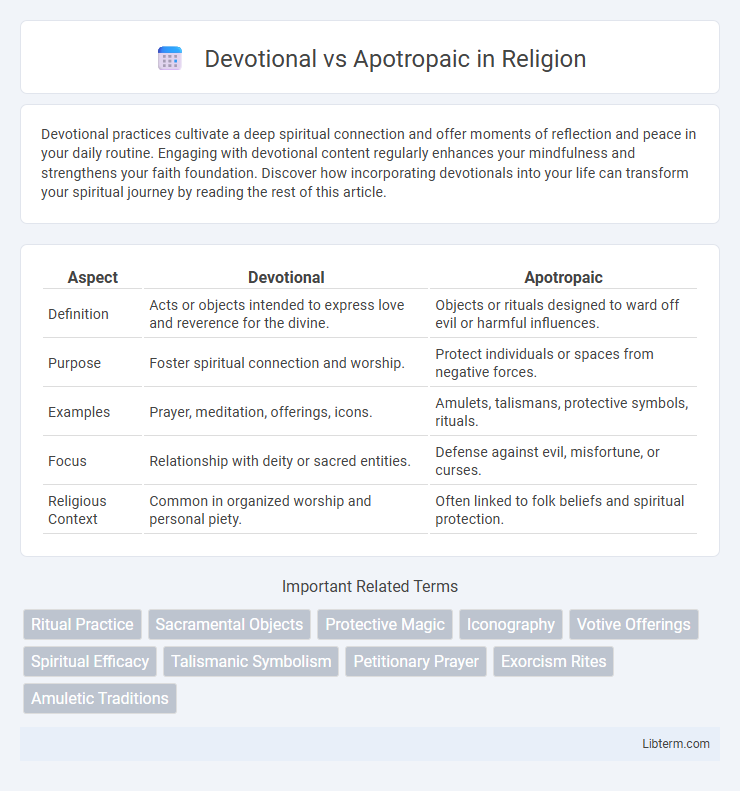Devotional practices cultivate a deep spiritual connection and offer moments of reflection and peace in your daily routine. Engaging with devotional content regularly enhances your mindfulness and strengthens your faith foundation. Discover how incorporating devotionals into your life can transform your spiritual journey by reading the rest of this article.
Table of Comparison
| Aspect | Devotional | Apotropaic |
|---|---|---|
| Definition | Acts or objects intended to express love and reverence for the divine. | Objects or rituals designed to ward off evil or harmful influences. |
| Purpose | Foster spiritual connection and worship. | Protect individuals or spaces from negative forces. |
| Examples | Prayer, meditation, offerings, icons. | Amulets, talismans, protective symbols, rituals. |
| Focus | Relationship with deity or sacred entities. | Defense against evil, misfortune, or curses. |
| Religious Context | Common in organized worship and personal piety. | Often linked to folk beliefs and spiritual protection. |
Understanding Devotional Practices
Devotional practices center on expressing reverence and fostering a personal connection with a deity or spiritual figure through rituals, prayers, and offerings. These acts are designed to cultivate faith, devotion, and spiritual growth, distinguishing them from apotropaic practices, which aim to ward off evil and negative influences. Understanding devotional practices highlights their role in building communal identity and individual spirituality within religious traditions.
Defining Apotropaic Traditions
Apotropaic traditions encompass rituals, symbols, and objects designed to ward off evil spirits, negative energies, or misfortune within various cultures. These practices often include amulets, charms, gestures, and prayers intended to protect individuals or communities from supernatural harm. Unlike devotional acts centered on worship or reverence, apotropaic customs emphasize defense and prevention against malevolent forces through symbolic or ritualistic intervention.
Historical Origins of Devotional Acts
Devotional acts trace their origins to ancient religious practices where offerings, prayers, and rituals were performed to establish a spiritual connection with deities or divine forces. These practices aimed at expressing faith and seeking blessings, often documented in early civilizations such as Mesopotamia, Egypt, and India, reflecting a deep cultural emphasis on worship and reverence. The historical roots of devotional acts highlight their role in fostering communal identity and personal piety throughout religious history.
Apotropaic Beliefs Through the Ages
Apotropaic beliefs have been integral across cultures, serving to ward off evil influences through symbols, rituals, and objects such as amulets, talismans, and protective gestures. These practices, found from ancient Mesopotamian clay tablets to medieval European church carvings, emphasize the power of supernatural protection against malevolent forces. The persistence of apotropaic traditions in architecture, folklore, and religious ceremonies highlights their enduring role in safeguarding individuals and communities throughout history.
Key Elements of Devotional Rituals
Devotional rituals center on expressing reverence and deep emotional connection with a deity, incorporating prayer, chanting, and offerings as key elements to foster spiritual devotion. These rituals often involve symbolic actions such as lighting candles or incense, reading sacred texts, and participating in communal worship to strengthen faith and personal piety. The primary focus of devotional practices is cultivating a sustained relationship with the divine through acts of love, gratitude, and surrender.
Common Apotropaic Symbols and Objects
Common apotropaic symbols and objects include the Evil Eye amulet, Hamsa hand, and gargoyles, all believed to ward off negative energies and evil spirits. These artifacts are often used in various cultures as protective talismans embedded in jewelry, architecture, and household items. Unlike devotional objects used primarily for worship or veneration, apotropaic items serve a defensive spiritual function by repelling harm and misfortune.
Psychological Impact of Devotion
Devotional practices cultivate a profound psychological impact by fostering feelings of purpose, emotional stability, and inner peace through ritualistic engagement and faith-based connection. These practices often activate the brain's reward pathways, enhancing mood and reducing stress by promoting a sense of community and spiritual fulfillment. Unlike apotropaic rituals, which primarily aim to ward off evil or misfortune, devotional activities center on positive reinforcement of belief, strengthening mental resilience and emotional well-being.
Protective Functions of Apotropaic Practices
Apotropaic practices serve distinct protective functions by warding off evil spirits, negative energy, and malevolent forces through rituals, symbols, and objects such as talismans or amulets. These practices contrast with devotional acts, which primarily focus on expressing faith and seeking blessings from deities. The effectiveness of apotropaic methods lies in their culturally embedded power to prevent harm and ensure spiritual safety in various communities worldwide.
Overlaps Between Devotional and Apotropaic Methods
Devotional and apotropaic methods overlap in their use of symbolic rituals, objects, and gestures intended to invoke protection and spiritual favor. Both practices frequently employ sacred imagery, prayers, and amulets to establish a protective presence that wards off evil influences while fostering a devotional connection to divine entities. This convergence highlights their shared purpose in safeguarding individuals through faith-based actions rooted in cultural and religious traditions.
Contemporary Relevance and Adaptations
Devotional practices continue to shape contemporary spirituality by fostering personal and communal connections to the divine through prayer, rituals, and symbols. Apotropaic elements, such as talismans and protective icons, remain prevalent in modern culture as psychological tools against fear and uncertainty, often integrated into architecture and popular media. Both devotional and apotropaic adaptations reflect evolving beliefs while preserving ancient intentions of protection, healing, and spiritual empowerment.
Devotional Infographic

 libterm.com
libterm.com